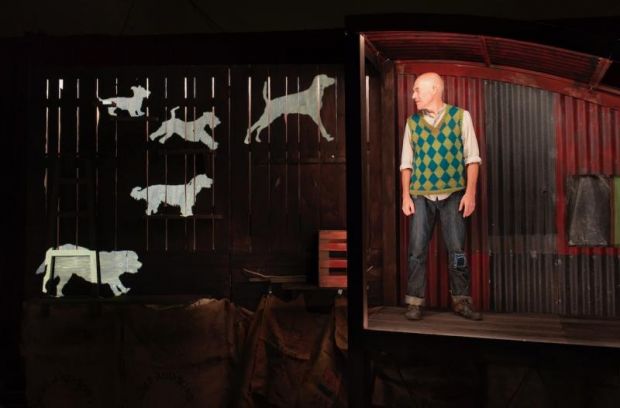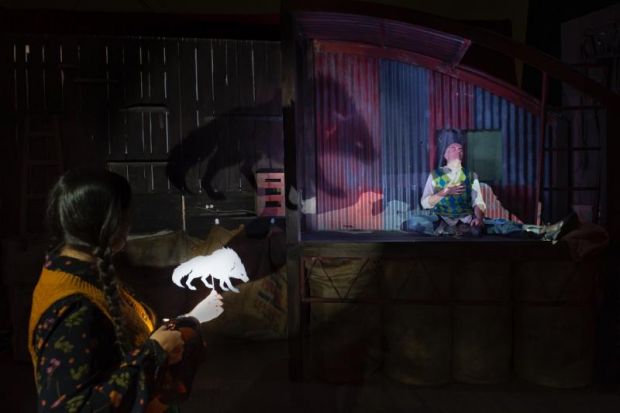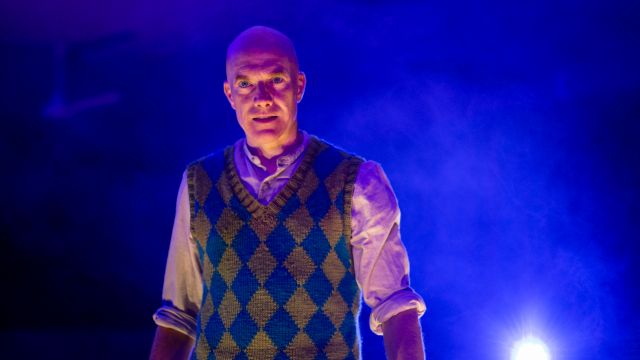The Boy Who Talked to Dogs
‘What’s wrong with you?’ screams almost everyone in Marty’s life, but there’s little wrong with this wonderful piece of theatre from South Australia’s Slingsby and State Theatre Company.
Marty McKenna (Bryan Burroughs) is the self-proclaimed ‘runt’ of his Irish family – last to be born and barely alive - he struggles in his childhood with compulsive behaviours and abusive role models, finding solace only with his dogs, Major and Rex. They are all Marty has in his life to calm him, until an incident of self-defence sees them removed from the family home in County Limerick – triggering Marty to run away. His canine connections continue with strays, becoming one of the pack in its efforts to survive.
Marty is telling his story in the Harp and Hound pub, alternating between the scared schoolboy and scarred adult, encouraged by the muso (Victoria Falconer) to share his story. It is framed with Irish music expertly played live by the small band (Emma Luker, Quincy Grant, and Falconer).

Burroughs commands the play from his first words until the final light fades: the emotional range he displays as he runs around the room is tremendous; as schoolboy and adult, he is utterly convincing. As well as providing good support in coaxing Marty to tell his story, Falconer has a beautiful voice for Lisa O’Neill’s songs, the music knowing when to underline the story and when to take charge of it.
The brilliant set (designed by Wendy Todd) spans the entire room as a pub: one corner is a stage for the musicians, the other three each have a small but significant set hidden behind massive doors. The audience sits six at a time, around tables decorated only with a lamp, each table arranged around a central circular stage. The entire room is the performance area – the audience turns in response to a sound behind, or to follow the effervescent Burroughs as he navigates a path amidst them, standing out in his bold knitted vest. This, and other costumes (designed by Ailsa Paterson), add to the story as well – the bright contrasts of Marty’s vest reflect the chaos in his brain; the flowers on the Muso’s skirt, life amongst the bleak.

The lighting is another star in this production: designed by Chris Petridis, it begins functionally, but soon the table lamps become part of the action, flickering with smashes, and changing colour to reflect the present mood of the story. Light is also key to the representation of the dogs in the show, with torches casting shadows of puppet animals onto the walls, and to Burroughs himself – the interactions between him and these shadows are wonderfully believable.
Clara Solly-Slade’s puppets extend to the video projections, adding animation to the shadows – the movement is still that of a stilted puppet, rather than trying to represent a living animal. This detail allows the story to keep the foreground, and this is true of every component of the show.
Director Andy Packer has brought all of this together so precisely: everything has earned its place, yet nothing dominates so much to rival the story, originally a book by the real Martin McKenna, and adapted to this play by Amy Conroy. This is tremendous story-telling and outstanding theatre. That it was created across two continents during a global pandemic is an achievement that should not be understated. It’s also a complete story – there’s no shying away from Marty as an awkward, broken boy, or the awful treatment he had from his father and teachers. It’s like a decent Irish stout: there’s dark bitterness beneath the cream on top – and this play tastes magnificent.
Mark Wickett
Photographer: Jessica Zeng.

Subscribe to our E-Newsletter, buy our latest print edition or find a Performing Arts book at Book Nook.

